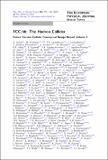| dc.contributor.author | Abada, A. | |
| dc.contributor.author | Abbrescia, M. | |
| dc.contributor.author | AbdusSalam, S. S | |
| dc.contributor.author | Abdyukhanov, I. | |
| dc.contributor.author | Abelleira Fernandez, J. | |
| dc.contributor.author | Abramov, A. | |
| dc.contributor.author | Aburaia, M. | |
| dc.contributor.author | Acar, A. O | |
| dc.contributor.author | Adzic, P. R | |
| dc.contributor.author | Agrawal, P. | |
| dc.contributor.author | Aguilar-Saavedra, J. A | |
| dc.contributor.author | Aguilera-Verdugo, J. J | |
| dc.contributor.author | Aiba, M. | |
| dc.contributor.author | Aichinger, I. | |
| dc.contributor.author | Aielli, G. | |
| dc.contributor.author | Akay, A. | |
| dc.contributor.author | Akhundov, A. | |
| dc.contributor.author | Aksakal, H. | |
| dc.contributor.author | Albacete, J. L | |
| dc.contributor.author | Albergo, S. | |
| dc.date.accessioned | 2021-09-20T17:29:32Z | |
| dc.date.available | 2021-09-20T17:29:32Z | |
| dc.date.issued | 2019-07-05 | |
| dc.identifier.uri | https://hdl.handle.net/1721.1/131672 | |
| dc.description.abstract | Abstract
In response to the 2013 Update of the European Strategy for Particle Physics (EPPSU), the Future Circular Collider (FCC) study was launched as a world-wide international collaboration hosted by CERN. The FCC study covered an energy-frontier hadron collider (FCC-hh), a highest-luminosity high-energy lepton collider (FCC-ee), the corresponding 100 km tunnel infrastructure, as well as the physics opportunities of these two colliders, and a high-energy LHC, based on FCC-hh technology. This document constitutes the third volume of the FCC Conceptual Design Report, devoted to the hadron collider FCC-hh. It summarizes the FCC-hh physics discovery opportunities, presents the FCC-hh accelerator design, performance reach, and staged operation plan, discusses the underlying technologies, the civil engineering and technical infrastructure, and also sketches a possible implementation. Combining ingredients from the Large Hadron Collider (LHC), the high-luminosity LHC upgrade and adding novel technologies and approaches, the FCC-hh design aims at significantly extending the energy frontier to 100 TeV. Its unprecedented centre of-mass collision energy will make the FCC-hh a unique instrument to explore physics beyond the Standard Model, offering great direct sensitivity to new physics and discoveries. | en_US |
| dc.publisher | Springer Berlin Heidelberg | en_US |
| dc.relation.isversionof | https://doi.org/10.1140/epjst/e2019-900087-0 | en_US |
| dc.rights | Creative Commons Attribution | en_US |
| dc.rights.uri | https://creativecommons.org/licenses/by/4.0/ | en_US |
| dc.source | Springer Berlin Heidelberg | en_US |
| dc.title | FCC-hh: The Hadron Collider | en_US |
| dc.type | Article | en_US |
| dc.contributor.department | Massachusetts Institute of Technology. Department of Physics | |
| dc.contributor.department | Massachusetts Institute of Technology. Plasma Science and Fusion Center | |
| dc.identifier.mitlicense | PUBLISHER_CC | |
| dc.eprint.version | Final published version | en_US |
| dc.type.uri | http://purl.org/eprint/type/JournalArticle | en_US |
| eprint.status | http://purl.org/eprint/status/PeerReviewed | en_US |
| dc.date.updated | 2020-06-26T12:55:34Z | |
| dc.language.rfc3066 | en | |
| dc.rights.holder | The Author(s) | |
| dspace.embargo.terms | N | |
| dspace.date.submission | 2020-06-26T12:55:34Z | |
| mit.license | PUBLISHER_CC | |
| mit.metadata.status | Authority Work and Publication Information Needed | |
